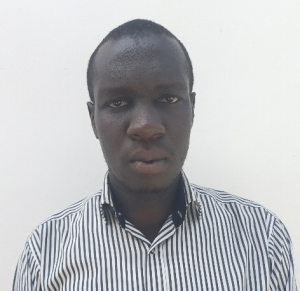The Emusaka area is vegetative, with community members living as small-scale farmers, including farm fish. The roads in this area are mostly untarmacked, dusty during the dry season, and muddy during the rainy season. The houses are semi-permanent in nature. This community works together with a common goal of improving their lives. They use merry-go-round banking groups to fund their own development projects of interest, and some people own tents that they lease out to individuals who have events. It is a very active community.
210 people in Emusaka rely on unprotected Manasses Spring for water. The spring water is highly contaminated with dirt, algae, rotting leaves, bugs, and animal and human activity because it is open. When it rains, runoff pours more dirt and farm chemicals into the spring, making it worse. The water is wholly unfit for human consumption. Community members frequently report cases of waterborne diseases and water-related illnesses, including typhoid, cholera, and amoeba. These diseases are expensive to treat, taking away time, energy, and money that community members would have allocated to other endeavors.
The spring water is not only dirty but difficult to access. To fetch water, community members have to use small jugs and a bowl to scoop water from the shallow pool that forms at the spring. They then pour the scooped water into their larger jerrycans, which are too big to submerge in the water.
The scoop-pour method is tiring and time-consuming, wasting many people's time and delaying their daily routines. But, if people try to fetch water too fast, they risk stirring up mud from the pool's bottom into the water they collect. When this happens, people have to wait even longer for the water to settle before they can begin fetching again. To time their fetching with the calmest and, therefore, cleanest water in terms of debris, most community members fetch water very early in the morning and late in the evening. This leads to a lot of crowing and long wait times.
"When there are many people collecting water, the water becomes dirty. You have to wait for it to settle before fetching, which is time-consuming," said Repha Ayako, a farmer in the community.
"The water is not safe for drinking and also dirty. I have to go to look for clean water after school, and come back late into the night," said Tyrone, a teenaged student.
What We Can Do:
Spring Protection
Protecting the spring will help provide access to cleaner and safer water and reduce the time people have to spend to fetch it. Construction will keep surface runoff and other contaminants out of the water. With the community’s high involvement in the process, there should be a good sense of responsibility and ownership for the new clean water source.
Fetching water is a task predominantly carried out by women and young girls. Therefore, protecting the spring and offering training and support will help empower the female members of the community by freeing up more of their time and energy to engage and invest in income-generating activities and their education.
Training on Health, Hygiene, COVID-19, and More
To hold training during the pandemic, we work closely with both community leaders and the local government to approve small groups to attend training. We ask community leaders to invite a select yet representative group of people to attend training which will then act as ambassadors to the rest of the community to share what they learn. We also communicate our expectations of physical distancing and wearing masks for all who choose to attend.
The training will focus on improved hygiene, health, and sanitation habits in this community. We will also have a dedicated session on COVID-19 symptoms, transmission routes, and prevention best practices.
With the community’s input, we will identify key leverage points to alter their practices at the personal, household, and community levels to affect change. This training will help ensure participants have the knowledge they need about healthy practices and their importance to make the most of their water points as soon as the water is flowing.
Our team of facilitators will use a variety of methods to train community members. Some of these methods include participatory hygiene and sanitation transformation, asset-based community development, group discussions, handouts, and demonstrations at the spring.
One of the most important issues we plan to cover is handling, storing, and treating water. Having a clean water source will be extremely helpful, but it is useless if water gets contaminated by the time it is consumed. The community and we strongly believe that all of these components will work together to improve living standards here, which will help to unlock the potential for these community members to live better, healthier lives.
We will then conduct a small series of follow-up training before transitioning to our regularly scheduled support visits throughout the year.
Training will result in the formation of a water user committee elected by their peers that will oversee the spring's operations and maintenance. The committee will enforce proper behavior around the spring and delegate tasks that will help preserve the site, such as building a fence and digging proper drainage channels. The fence will keep out destructive animals and unwanted waste, and the drainage will keep the area’s mosquito population at a minimum.

 Protected Spring
Protected Spring
 Rehabilitation Project
Rehabilitation Project

































